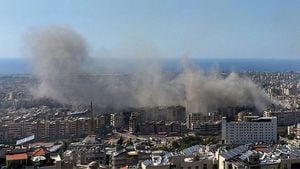Myanmar remains engulfed in turmoil as the military continues its aggressive campaign against resistance forces, leading to tragic civilian casualties and widespread destruction. Recent events have thrown the political and humanitarian crises to the forefront, with airstrikes targeting heavily populated areas and clashes between junta forces and various ethnic armed groups intensifying.
On November 11, 2024, the junta conducted airstrikes on the city of Mogok, located within the Mandalay Region, resulting in the deaths of four civilians and the destruction of at least nine homes. Eyewitness accounts described the devastation, with one local stating, “U Khaing Myint’s home, U Tun Sein’s home, and several others were destroyed. The entire Lel Oo neighborhood in the east was wiped out.” The strikes hit primarily residential areas controlled by the revolutionary forces, including the Ta’ang National Liberation Army (TNLA) and the People's Defence Forces (PDF), who have held Mogok since July. Following the air raid, local residents were forced to evacuate under the cover of night for safety, raising the stakes for those remaining within the fighting zones.
Meanwhile, the situation has escalated dramatically elsewhere. Even as the TNLA continues to resist, the junta's airstrikes have reportedly killed at least 20 individuals over two days—nine fatalities on November 11 due to bombings near Mogok and eleven at a tea shop in Nawnghkio the following day. The TNLA spokesperson, Lway Yay Oo, shared, “Junta airstrikes target civilians, yet we are still prepared to engage in peace talks.” The violence has escalated under the regime's recent campaigns to dominate areas regarded as strongholds of ethnic resistance.
The toll of these airstrikes and ground battles is not just measured by the fatalities; it also reveals the dire humanitarian crisis facing many citizens. Reports indicate massive displacements, with many fleeing regions suddenly caught up in conflict. An alarming number of residents flee to Escaping from towns like Ann, where approximately 300 junta soldiers reportedly surrendered to the Arakan Army (AA) amid intense fighting. Local sources confirmed the visible AL flags at several governmental buildings, indicating control shifting amid chaos.
Also, as the fighting escalates and retreats occur among the ranks of junta soldiers, the military has reportedly implemented intensified airstrikes to maintain control. Many local residents express their increasing fear and anxiety, urging nearby communities to remain alert for possible future assaults. One resident described this as, “The situation for the Military Council is serious,” reflecting the mounting pressure the junta is experiencing from local militias and armed forces. Simultaneously, the junta struggles against regional autonomy movements, which continue to gain momentum under these conditions.
Overall, experts and on-the-ground observers note the increasing desperation of the junta, with even senior officials reportedly acknowledging the crisis within their ranks. The recent surrender of numerous troops and the uptick of rural consternation suggest the military operation is becoming untenable. This is exacerbated by reports of foreign pressure on the regime, particularly from regional players concerned by the upswing of civil unrest.
Aeroplanes and helicopters are at the forefront of these military operations, consistently seen above towns like Pale Township. There, relentless bombardments by the military have resulted in civilian deaths and heightened risks. Official reports continue to confirm fierce fighting as various resistance forces, including the Burma National Revolutionary Army (BNRA), strive to capture key strategic locations like the police station and regional administration offices.
Expectations for peace are thin on the ground as discussions of ceasefires yield little more than rhetoric. The intertwined crises of war, forced displacements, and rising tensions between armed factions remain prevalent. Residents live under continued threat, devoid of any immediate relief or hope for the restoration of order. Meanwhile, the international community watches, with calls for accountability becoming ever more urgent as civilian lives continue to be lost.
The political ramifications of these events cannot be overstated. The military's tactics not only contravene the fundamental principles of human rights and international law but also signify the regime's refusal to cede control, no matter the cost. Humanitarian organizations warn against the impending crisis as infrastructure collapses and supplies dwindle, risking even greater fallout for innocent civilians caught up within these fracturing lines of conflict.
Undoubtedly, as air raids escalate and ground skirmishes continue to claim lives, the situation demands urgent international attention. It sheds light on the brutal reality facing Myanmar's civilian population and the resilience exhibited by various groups fighting for their rights and independence. Myanmar's crisis is far from resolved—every day, the plight of its people serves as a grim reminder of the pressing need for comprehensive action against such acts of violence.
With the junta’s military actions intensifying without regard for civilian life, the international community must respond with coordinated pressure to bring about cessation of hostilities, provide humanitarian aid, and catalyze meaningful dialogue toward peace.



